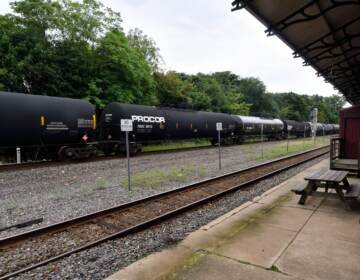One year after Amtrak 188 derailment, where does the region stand on Positive Train Control?

Thursday marks the one-year anniversary of the Amtrak 188 derailment in North Philadelphia. The crash, which killed eight and injured hundreds more, could have been prevented by a new safety technology known as Positive Train Control (PTC).
At the time of the crash, both SEPTA and Amtrak were working on implementing the safety system, which helps prevent crashes caused by human error, automatically hitting the brakes on speeding trains when the engineer fails to respond to warning signals. Such a system would have prevented Amtrak 188 from jumping the rails when it entered a the Frankford Junction curve going 102 miles per hour, more than 50 mph faster than it should have been travelling.
The National Transportation Safety Board will release its official finding on the crash’s probable cause on May 17th.
Amtrak installed PTC on its Northeast Corridor in December, and SEPTA activated PTC on its Warminster line in April. SEPTA General Manager Jeffrey Knueppel says he is “very hopeful” that SEPTA can have PTC activated on all of its regional rail trains by the end of July.
Next up will be the Fox Chase and Doylestown lines. One of the two lines—SEPTA hasn’t decided which yet—will have PTC activated on May 23rd, with the other following soon after. SEPTA wants to implement PTC on all of its single track lines—Warminster, Fox Chase, and Doylestown—first, then go on to double track and multiple track lines.
While PTC helps trains communicate with one another and the track’s signal system, human errors only account for about 35 percent of train crashes, which are exceedingly rare to begin with. Even though it was active at the time, PTC did not prevent the Amtrak collision outside Chester, PA in April that killed two workers and injured 31 aboard the train. There, communications between the workers and Amtrak trains broke down, tragically demonstrating a safety issue unaddressed by PTC.
Congress required forty-one intercity commuter and freight railroads to implement PTC in the Rail Safety Improvement Act of 2008. Originally, Congress gave a December 31, 2015 deadline, one that SEPTA and Amtrak raced to meet. But with just one other rail operator, Los Angeles’ Metrolink, on pace to even get close to making the deadline, Congress extended it last October to 2020.
Other railroads in the region are taking full advantage of the extension. NJ Transit says they’ll install PTC by the end of 2018. Freight railroad lines CSX and Norfolk Southern say they won’t be able to get PTC installed until 2020.
WHYY is your source for fact-based, in-depth journalism and information. As a nonprofit organization, we rely on financial support from readers like you. Please give today.




